To cope with the surge of patients in outbreak countries, the clinical practitioners on the front lines in China have developed a handbook of treatment protocols for healthcare providers to fight against COVID-19. Visit https://covid-19.alibabacloud.com/ to get your copy today!
By Cui Liang (Zhenshui)
In the face of the sudden outbreak of the novel coronavirus in 2020, the 1.4 billion people of China are coming together to weather this difficult time. Alibaba knows that it must do its part. We are putting our advanced technology at the service of public health and safety. In DingTalk Groups, many people have interacted with the "Epidemic Prevention Elf" (防疫精灵), which provides important news from across the country in real time. It can answer various questions you may have, providing epidemic prevention knowledge, online consultations, information on confirmed cases near your community, and the location of clinics. Even more impressive, the Epidemic Prevention Elf robot went from an idea to operation on DingTalk in a single afternoon. It has already served at least 5 million DingTalk users. Our Robot Factory is what allowed us to achieve this seemingly impossible task. Robot Factory is a powerful incubation platform for intelligent chatbots. Its sophisticated natural language processing (NLP) algorithms and powerful Q&A capabilities make everything possible.
In 2016, the world entered the chatbot era, with many technology giants releasing their own chatbot products, such as Apple Siri, Microsoft Xiaobing, Baidu Xiaodu, and Alibaba Tmall Genie. The emergence of chatbots has changed how humans interact with computers. From computer-centered ordered operation instructions, we have now adopted a user-centered approach based on natural language conversational AI.
The Robot Factory is an incubation platform for intelligent chatbots that emerged as part of the conversational AI trend. With Robot Factory, anyone can build a dedicated chatbot in just one minute without having to concern themselves with the details of NLP technology and programming issues.
The following figure shows the overall architecture of Robot Factory. The following sections will describe the application scenarios and core capabilities of Robot Factory in detail.
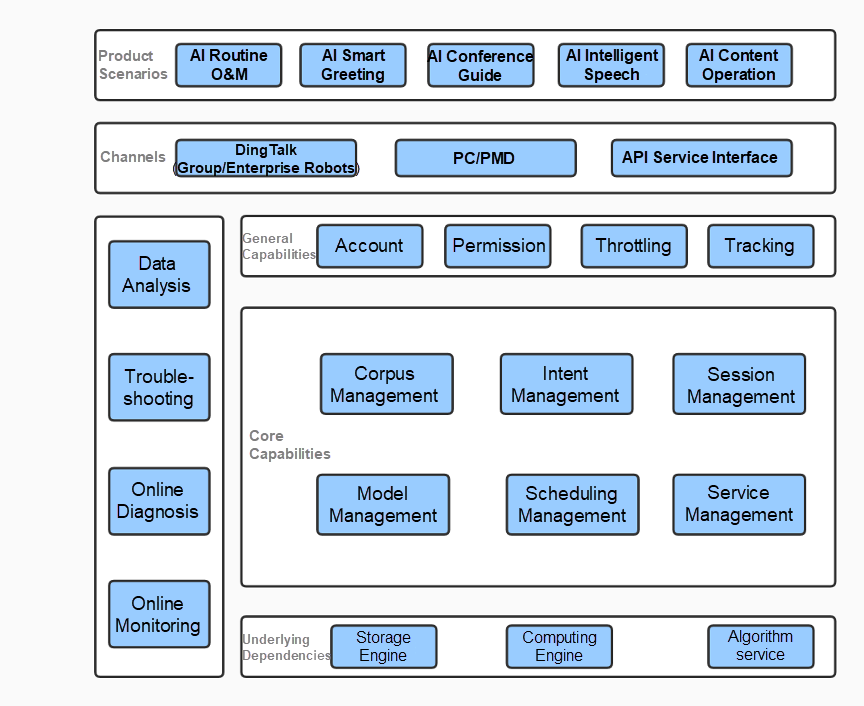
There are three main application scenarios for Robot Factory: Q&A, operation, and O&M.
Q&A is the most common of the three scenarios. Consumers always ask a lot of common and repeated questions about the products of merchants, and employees do the same about the rules and regulations of their companies. In such scenarios, common questions are extracted and sorted into Q&A pairs and then collected by the Robot Factory platform. Then, you can design a Q&A robot to help answer most of the questions, saving time and effort while reducing labor costs. For example, Robot Factory provided a conference guide robot for the Apsara Conference.
In operation scenarios, robots are mainly used to quickly and precisely send messages to all users. For example, if you run 100 business groups from all over the world, you can promptly communicate with them by setting the relevant message content and sending time in Robot Factory. This eliminates the need to perform 100 repeated operations, which are inefficient and time-consuming.
In O&M scenarios, robots not only answer questions but can also run commands. For example, you have purchased a server on Alibaba Cloud and ran some tasks. Then, you can ask the robot to help you query the progress of the tasks, detect exceptions, and terminate abnormal tasks. The O&M process is as follows: The user asks a question > The robot receives and understands the command > The robot calls a service (executes a command) > The robot returns a response to the user.
There are also many other possible use cases of robots. For example, by integrating speech-to-text technology, a smart greeting robot has been co-developed by Alibaba Cloud Communications and Cainiao Post. Robots can be used to administer questionnaires, return phone calls, confirm if consumers are home when dispatching onsite service personnel, and perform many other tasks. By using robots, companies can make many more phone calls per day than before.
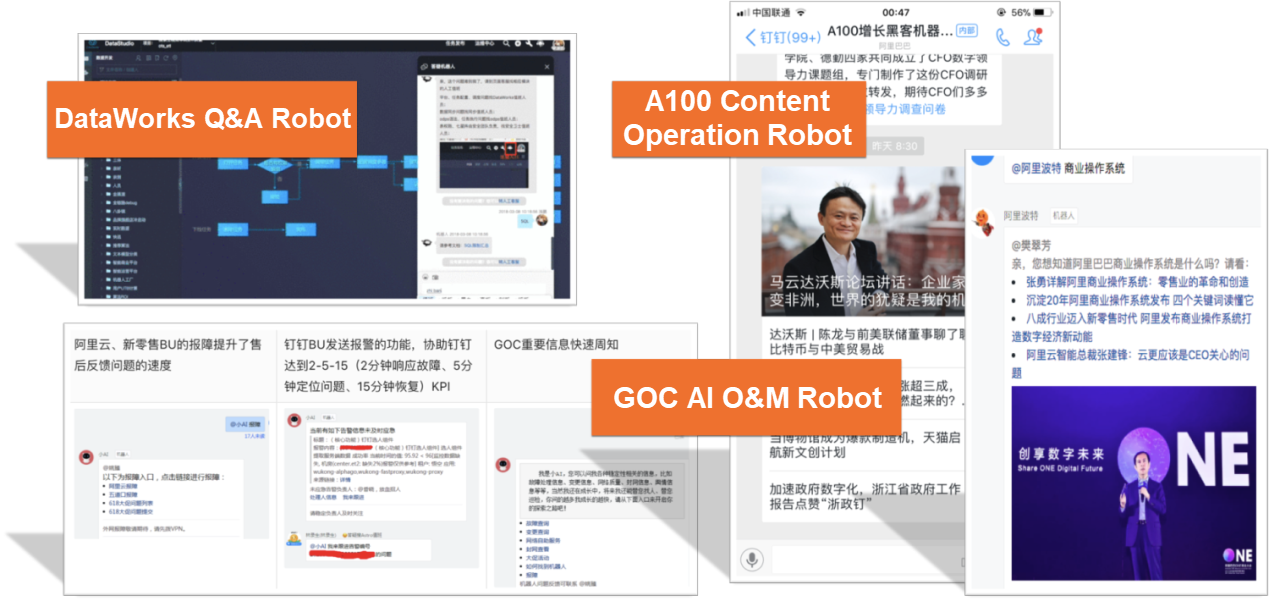
Now, I want to show you more about what Robot Factory can do. The following sections describe the core capabilities of Robot Factory and how you can take advantage of them.
Smart conversation robots provide Q&A services. Such scenarios involve two concepts: intent and entity. An intent consists of a user input, action, and response. The user input defines the user's question, and the response defines the corresponding answer. The action is an optional step and defines the series of commands that needs to be executed based on the robot's understanding of the user's intent. Entities extract structured information from the user input, efficiently solving the problem posed by a large number of similar intent matching scenarios. For example, assume a user asks "How is the weather in Hangzhou on March 8, 2020?" In this case, "Hangzhou" can be extracted into an enumeration entity, and "March 8, 2020" can be extracted into a regular entity. The action can be defined as calling a service to query the weather by city and time. Finally, the response returns the weather information.
The preceding example reflects that a Q&A robot must first precisely understand the user's intent before performing an action. The underlying layer of Robot Factory provides a complete algorithm framework. In this framework, traditional machine learning algorithms are combined with NLP algorithms based on deep neural networks. In addition, the framework combines the training of the offline feature extraction model with online real-time prediction. To improve the accuracy of intent matching, the system combines plain text-based FAQ intent matching and entity slot-based intent matching. We will not go into this topic in detail here. Instead, it will be detailed later in a special article.
To some extend, the intelligence of a chatbot depends on the richness of the corpus it understands. However, most knowledge is accumulated in non-structured text instead of the Q&A format that a chatbot can understand. Therefore, we need to find a way to quickly build a corpus with smart Q&A capabilities for new chatbots. Robot Factory provides three methods to solve cold startup problems. For a single robot application, the corpus can be enriched through corpus crawling (automatic), batch import (manual), and preset intents (public system corpuses). In addition, corpuses can be shared among multiple applications (through application assembly).
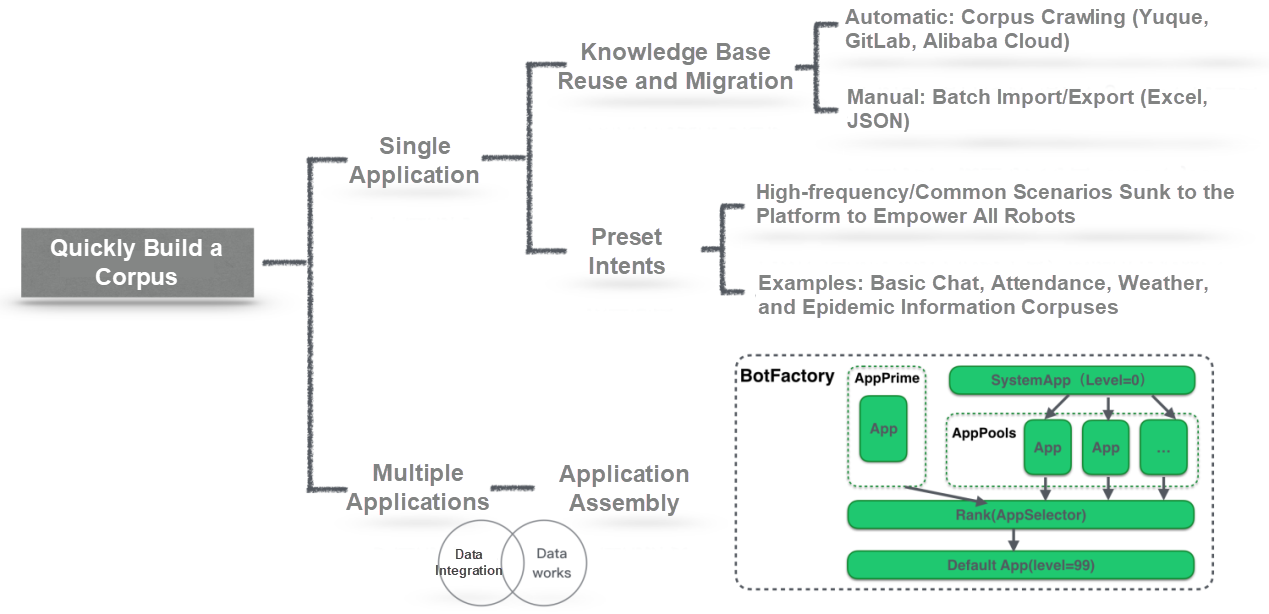
With machine reading and understanding capabilities, corpus crawling automatically extracts information from your existing non-structured knowledge bases or documents into Q&A pairs that can be understood by the chatbot. Corpus crawling not only replaces manual input to quickly enrich the corpus of the chatbot, but also greatly reduces the migration costs of interfacing knowledge bases with Robot Factory. Currently, 80% of the corpuses on the Robot Factory platform are generated by corpus crawling. You can also manually import multiple corpus files in Excel or JSON format to automatically generate intent information.
The preset intent feature allows Robot Factory to sink high-frequency and common scenarios to the platform level to empower all robot applications on the platform and enhance their Q&A capabilities. Here, the common scenarios include chatting, weather query, and attendance query. Then, you only need to enable certain options on the platform to give your chatbot the ability to answer these questions.
The corpus sharing feature allows different chatbots to reuse corpuses. For example, all the member manuals of Intime Retail are consistent, but different subsidiary stores have different promotion activities. Robot Factory allows you to create one robot, Robot A, based on the universal corpus and create other robots based on different corpuses. However, all robots will share the corpus of Robot A. Corpus sharing improves the reusability of your corpuses, allowing you to focus more on differentiation for different scenarios.
As mentioned earlier, an intent consists of three parts: user input, action, and response. An action defines a series of commands to be executed after the robot understands the user's intent. Generally, the action calls a service defined by the user through an HTTP request. However, users often encounter the following problems:
To solve these problems, Robot Factory cooperated with App Studio, an online development tool of the Alibaba Cloud DataWorks, to develop an App Studio-based online service development integrated development environment (IDE). This provides users with a cloud-based online programming platform, which helps you connect with downstream services to implement features such as data query, command execution, knowledge base search, and content recommendation. This platform provides you with the following advantages:
After two years of development and improvement within the Alibaba Group, Robot Factory has incubated more than 10,000 robots and served more than 440,000 users. Participating in the Apsara Conference for two consecutive years, we felt the strong demand of users for intelligent robots. Therefore, in 2020, we officially released Alibaba Cloud Robot Factory. If you want to customize a chatbot to reduce labor costs and improve work efficiency, contact us.
Finally, we have prepared a demo of the one-click Q&A robot created by Robot Factory for DataWorks. For more information, stay tuned for forthcoming articles about Robot Factory.
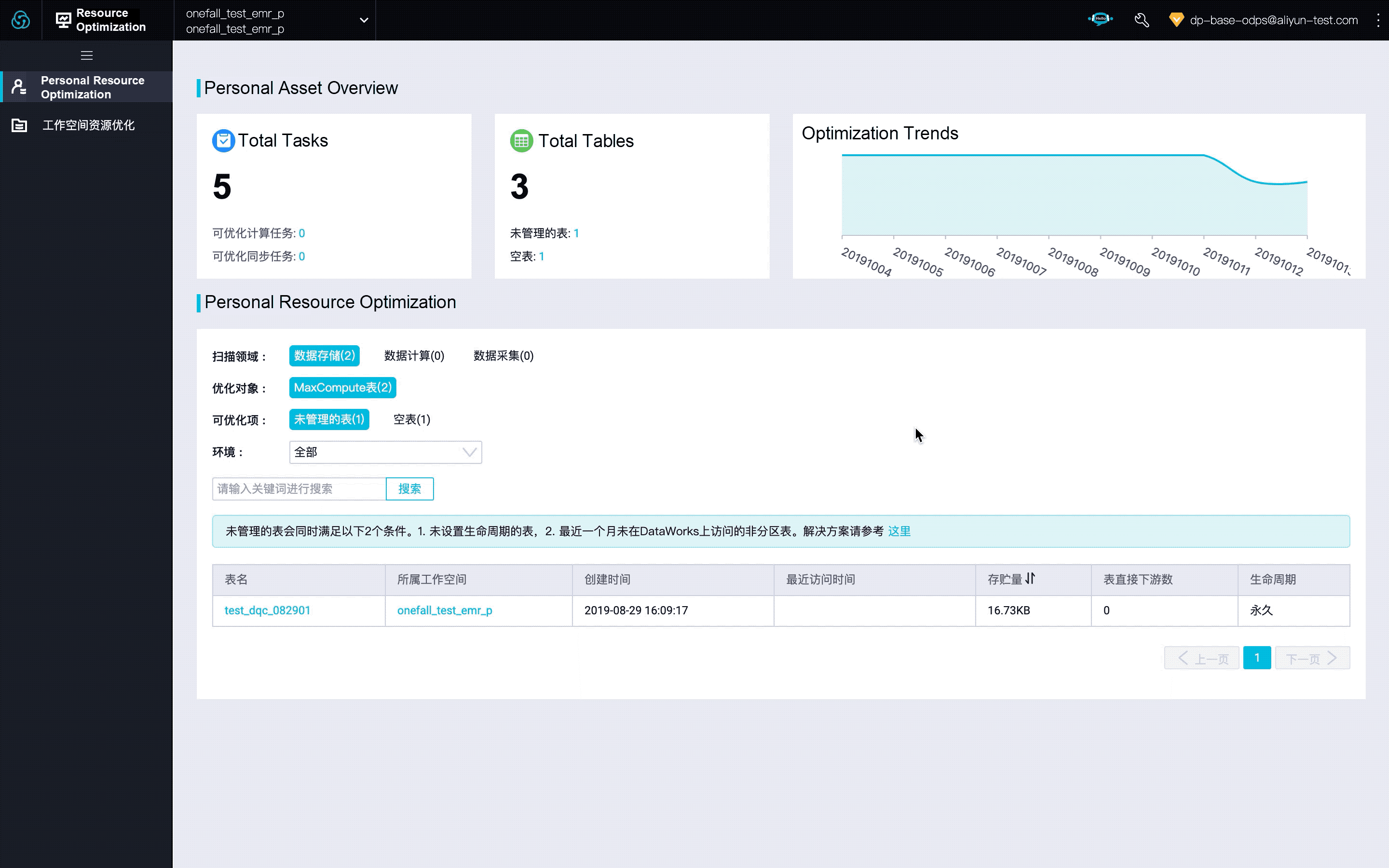
While continuing to wage war against the worldwide outbreak, Alibaba Cloud will play its part and will do all it can to help others in their battles with the coronavirus. Learn how we can support your business continuity at https://www.alibabacloud.com/campaign/supports-your-business-anytime
Jack Ma Foundation and Alibaba Foundation Ramp up Coronavirus Aid to Europe
Alibaba Unveils Technologies to Empower Partners in Fight against Coronavirus

2,599 posts | 769 followers
FollowAlibaba Clouder - March 12, 2020
Clouders - January 12, 2022
Alibaba Clouder - March 23, 2020
Alibaba Clouder - April 29, 2020
Alibaba Clouder - July 10, 2018
Alex - July 9, 2020

2,599 posts | 769 followers
Follow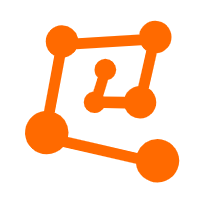 Intelligent Robot
Intelligent Robot
A dialogue platform that enables smart dialog (based on natural language processing) through a range of dialogue-enabling clients
Learn More Offline Visual Intelligence Software Packages
Offline Visual Intelligence Software Packages
Offline SDKs for visual production, such as image segmentation, video segmentation, and character recognition, based on deep learning technologies developed by Alibaba Cloud.
Learn More ApsaraVideo Media Processing
ApsaraVideo Media Processing
Transcode multimedia data into media files in various resolutions, bitrates, and formats that are suitable for playback on PCs, TVs, and mobile devices.
Learn More Realtime Compute for Apache Flink
Realtime Compute for Apache Flink
Realtime Compute for Apache Flink offers a highly integrated platform for real-time data processing, which optimizes the computing of Apache Flink.
Learn MoreMore Posts by Alibaba Clouder
Start building with 50+ products and up to 12 months usage for Elastic Compute Service
Get Started for Free Get Started for Free